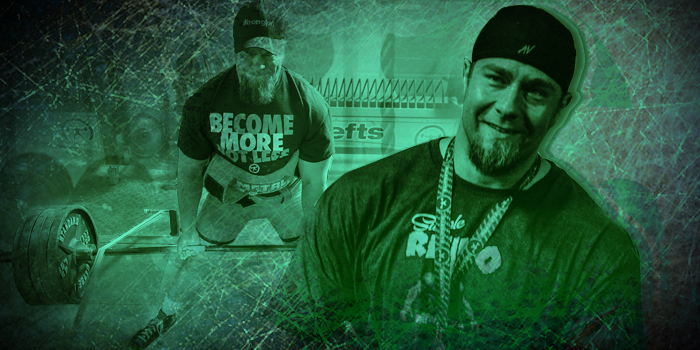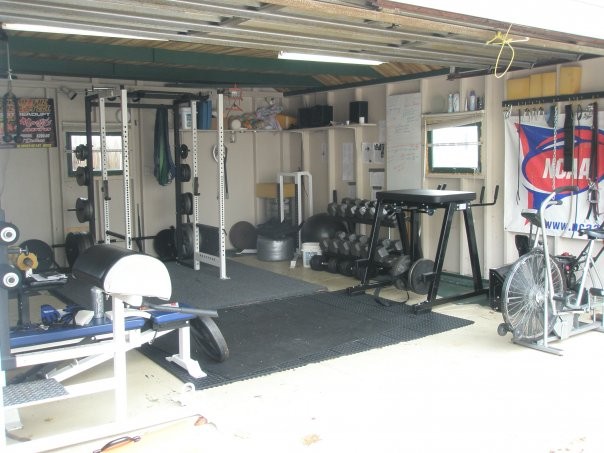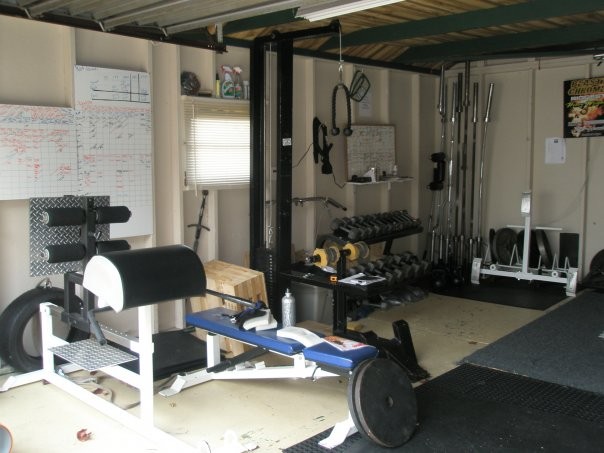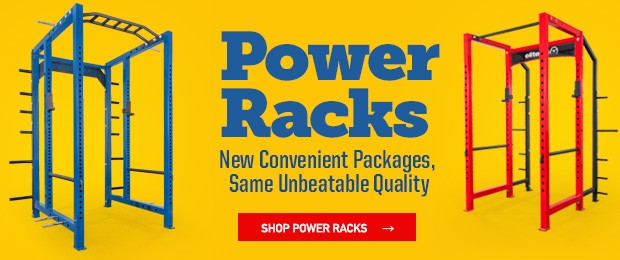
I hung up the phone and sat at the desk my dumbfounded. Where was I going to train? The gym I was training at had been sold. The powerlifter who owned all the powerlifting equipment was going to put it into storage or in his basement. He would not be inviting anyone to train at his house. The 15 to 20 powerlifters all had to find new lifting homes. Most ended up in groups of three or four, based on who could train together and where they were located. I had to train at a university weight room and then eventually at a health club. That was until I had a rack and an adjustable bench of my own. I was finally free!
Having your own space to train is one of the best investments you can ever make. When you start a home gym, sacrifices based on space and economics must be considered. In addition to the rack and bench, I owned three competition bars, bands, a sled, and barely enough plates to do max effort work. That was it. Over time I added more and more to accommodate what I needed to accomplish in my training.
With my Bare Bones program, you can see that great progress can be made with minimal equipment, but there are some tools that just make things easier. Each investment opens up more combinations and in some cases better options. If I had to do it all over again, these are the first things I would add to my home gym and why.

Under $50
The items under $50 are great as birthday, Christmas, or anniversary gifts. Any time you get a gift, really. Put it on your elitefts wish list and give it to your loved ones. Let them know what you really want.
This is almost a no-brainer. Above and beyond accommodating resistance and over-speed eccentrics, they are the most versatile item on this list. They take up very little space, they travel well, and they add hundreds of exercises and variations to a small space. Without a doubt, this is the first thing I bought from elitefts, even before I had my own space. Like I said, no brainer!
Everything on this list provides multiple uses. The Fat Gripz are great for simulating a fat bar, but also give you a small deficit to overcome. Now move them to the center and you are benching to a half-board without needing a partner. They fit on some dumbbells and they are great for curls, pull-ups, pulldowns, and extensions. With some creativity and bands, you have fat grip flyes, chest presses, or rows. Taking up less space than a pair of shoes, these are a great addition to upper body work.
If you train alone, the Shoulder Saver Pad is great to have around. No matter if you are doing max effort or high rep triceps work, it will get the job done. A full set of boards will take up more space but a two-board, three-board, and four-board will cover most needs for almost everyone. We use boards quite often and they take a good beating. After 10 years of abuse, the same boards sit in my gym and look to have another 10 years of life left in them. If you are not board pressing, read this right now. The boards and Shoulder Saver Pad provide less variety than bands but provide necessary variations needed for max effort work and supplemental pressing.
Under $100
The next items are under a hundred bucks and vary in their usefulness. No matter if you are training for size, strength, or being awesome at life, these are all good choices. Remember that this is my list. You might need to cross a few things off and write in your choices.
I don’t recommend the stability ball for the stability; I recommend it because we use ours for leg curls when someone can’t do glute ham raises. The hamstring at the hip is held in place while you leg curl just like doing a GHR. It is much harder to increase the intensity, but if space is in short supply this works in a pinch.
In addition to the leg curls, we use it for stir the pot, dumbbell pressing, planks, and other ab movements. This isn’t a one-trick pony, and though it takes up a chunk of space, it is easily moved. A word of warning about stability balls: you need to make sure it is anti-burst. I had one pop on me with 100-pound dumbbells in my hands. I made that mistake once. Never again. Buy nice, don’t buy twice!
A small space means skipping out on equipment with big footprints. A cable machine can be too tall for basements and eat up precious floor space. This is where Spud Inc. hit a home run! The low pulley system allows you to do pushdowns, low rows, and other lighter cable movements without eating up your space. I don’t need you to tell you how awesome this is and what you can do with it. The possibilities end with your creativity.
The Core Blaster is another piece that has a wide variety of uses and would fit into a shoebox. This, along with a few other items, could easily fit into a milk crate and hide in the corner. The only caveat is that an additional handle makes a huge difference in its applications.
Without a handle, you can still do Meadows rows, half-kneeling shoulder press, lumberjack squats, and grappler abs, which are all great. Add one of the specialty handles and you can do T-bar rows, Viking press, stiff leg deadlift, bent-over shrugs and more. We use the T-bar handle quite often and the combo has added a huge amount of versatility.
Even without the handle, this is a winner and should be on your short list of home gym items. No matter if you are an athlete, grandma, or powerlifter, this is for everyone.

Over $100
The sled was the first real piece of equipment that I purchased. That was in 2001 or 2002 and it is still going strong. This was and still is one of the best things I have ever used to improve my lower body strength and GPP. I just replaced the original strap last summer. That is 15 years of abuse, or less than $10 a year. It is a versatile piece and you will wear out before it does. No matter if you are trying to hit your quads, hamstrings, upper back, chest, shoulders, or lats, the sled can do it all.
There is a reason it was the first product that Dave sold and there is a reason he is still selling them: because they work and can benefit everyone! After bands, this would be the second thing on my list to purchase. You can do so much with it that the only downfall is that you have to do it outside unless you have a space big enough inside.
You need some variety to build your bench. This is even more important if you don’t have any dumbbells. So my choice for upper body specialty bar is the American Cambered Grip Bar. The grips are neutral so we can change the hand position. You can bench to a deficit or flip it over and shorten the range of motion. It will hammer your triceps and it works great for overhead press, extensions, rows, curls, or push-ups. For under $300 this is a great addition to a home gym and can really spice up your training.
I am sure some of you will argue with me about my choice of the RCB over the SS Yoke Bar, but let me explain. I don’t disagree that the SS Yoke Bar is great for squats, good mornings, and upper back work. I just believe the RCB has more overall applications and that is why I chose it. Squats and good mornings are a given, but this bar can also be used for overhead pressing, board pressing, Zercher squats, Zercher deadlifts, and even dead-stop extensions. You will get more low back work with the RBC and more upper back work with the SS Yoke Bar, but if I had to choose one I would go with the RBC.
Varied Price
Dumbbell work is a great tool with many applications. Depending on your situation I would personally pick up four or five pairs to start: a very light pair for rehab work (eights or 10's), then 25's, 50's, 75's, and 100's. This will cover most dumbbell work, and if something between is needed, use a combination of bands and dumbbells. The dumbbells you require will differ from everyone else, but buying a few pairs is a great place to start. Invest in the pro style so you can change the weights by as much as 15 pounds. It is a hassle but a space saver for sure. Price of each dumbbell will vary by weight.
My honorable mentions couldn’t quite beat out everything else on the list. After being weighed against the others, they were eventually dropped. Your list will be different when you list out your needs and priorities. Items like dip attachments for your rack, blast straps, sandbags, a weight vest, and medicine balls all can be argued. Yet floor space is a premium and you will want the most bang for your buck. So if you have what you need from above, these would be second tier items to consider purchasing. These are more for assistance and conditioning work so they were dropped off the main list. Cover your main exercises first then attack the assistance work.
When and if you are ready to add big pieces to your home gym, you need to consider the cost per square foot. Let’s look at a belt squat versus a GHR. The cost of a belt squat is considerably more than the GHR, and though it does offer many benefits, the footprint and cost compared to what you can do with the GHR is a huge difference. You can easily move a GHR if need be, but the belt squat is staying where you put it. Weigh the monetary cost, opportunity cost, and how you plan on using the equipment. In this situation give Matt Goodwin a call and he can help you make an educated decision on what is best for you.
That is my list and where I would invest in my home gym. Just because you can train with only a rack, bar, and bench doesn’t mean you should. Make your training more efficient and enjoyable with a better-built home gym. It is your space and your rules. Enjoy it.











3 Comments